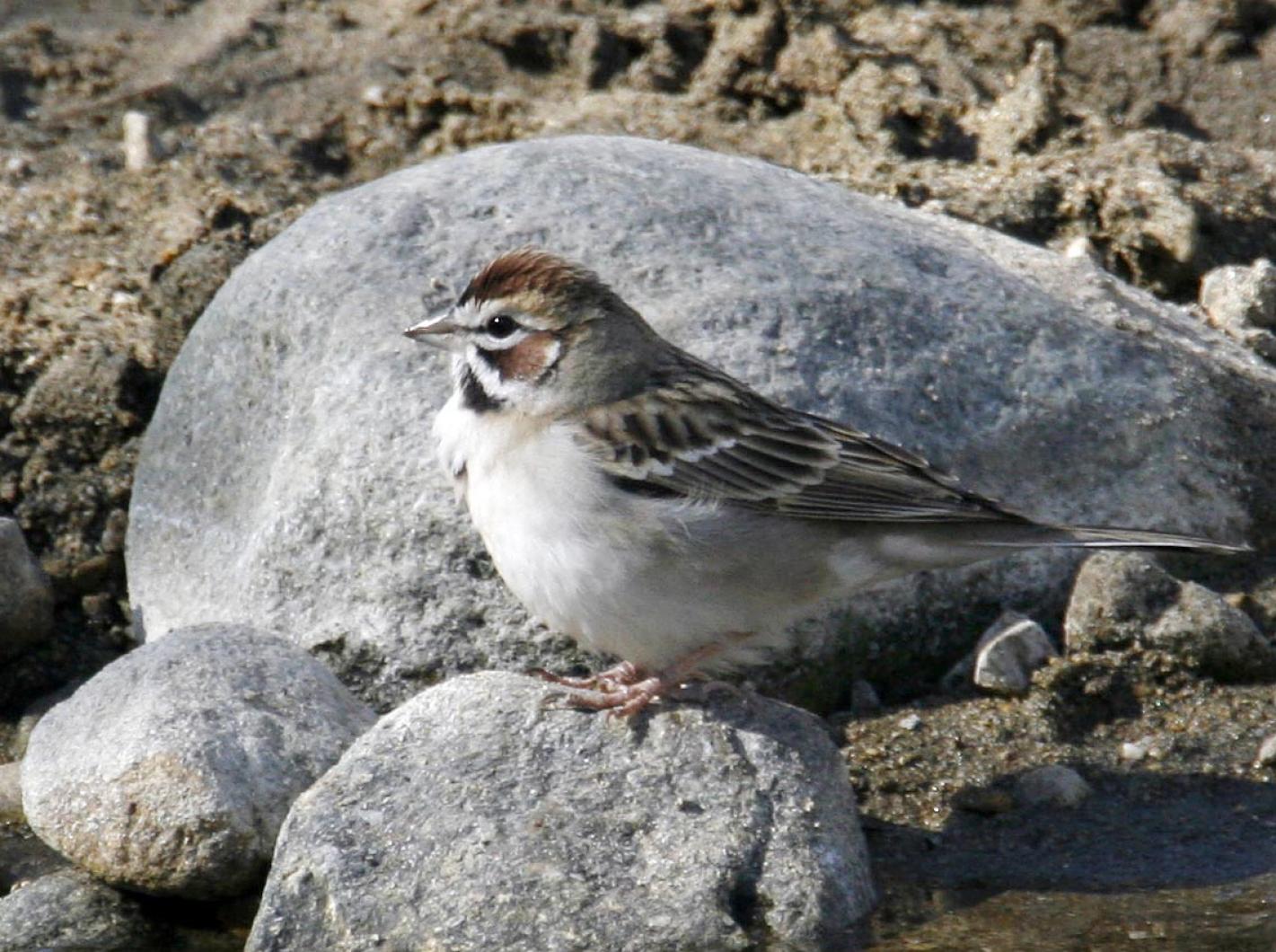Hey, in the world of bird watching there is nothing better than a bird that is easy to identify. And when you are dealing with sparrows it is particularly exciting. Most beginning birders barely even look at sparrows, claiming that they all look alike and they are just little brown jobs! This weekend we had a visit from a sparrow that is far from an LBJ (little brown job).
Sally Anderson and Laurie Walker were at the Gay Head Cliffs in Aquinnah early. They had been birding around Bob Shriber and Vern Laux but moved off to do another area. Sally was looking around the parking lot and spotted a lark sparrow. This sparrow has a lovely face pattern and white outer tail feathers which are very noticeable when in flight. She was able to show Laurie, Bob and Vern. Al Sgroi, Sue and Chip Strang and I arrived a bit later and luckily we were able to see the lark sparrow at close range perched on a viburnum bush.
The facial makeup is striking, showing a cheek patch and cap which is brick red and a strong, long, white eye stripe outlined by black. The lark sparrow has a white breast with a dark central spot. The sparrow’s tail is brown but when in flight or flared it is edged with black and the outer edges are stark white. This is far from a LBJ.
The lark sparrow is a west coast breeder and only is seen in New England in the fall, and then usually no farther than 10 miles inland. The Vineyard has visits from lark sparrows almost annually, but only one or two birds. These occurrences are usually either in Gay Head or Katama and during September and October. Unlike many other sparrows, they tend to enjoy feeding on seeds in open areas such as the parking lot at Aquinnah or along the road at Katama.
It would be fun to watch the courtship of the lark sparrow. The male struts his stuff on the ground near a female of his liking. While strutting the male lark sparrow flairs his tail showing the white edging and points his bill skyward. If the female likes what she sees, they mate, choose a site for the nest and proceed to raise a family. The female incubates the four to six eggs but both male and female feed the young when they hatch. It only takes about 10 days for the youngsters to fledge.
If the weather holds, the lark sparrow may still be in Aquinnah this weekend. If not, there will probably be other good migratory bird species to see.
Bird Sightings:
Rob Bierregaard announced that Penelope, the female osprey that was fitted with a satellite transmitter at Long Point this summer, set a record by making the trip from the Vineyard to Venezuela in 13 days flat. Homer, another of the Vineyard’s tagged osprey, left the Vineyard on the 23rd and so far has made it to Maryland. Maybe these two birds know something about the storm coming up the coast that we don’t! If you want great photos of the movements of Vineyard osprey go to the Web site bioweb.uncc.edu/bierregaard/migration08.htm
Gay Head Cliffs at Aquinnah have been the birding hot spots this week. The birders have included yours truly, Allan Keith, Laurie Walker, Sally Anderson, Al Sgroi, Chip and Susan Strang, Bob Shriber and Vern Laux. I will list the highlights although many species were seen daily.
On Sept. 16 Allan Keith and I spotted a least flycatcher and brown thrasher. At Quansoo Flip Harrington and I still had a ruby-throated hummingbird. We saw it again on Sept. 18 but it hasn’t been seen since. I would be interested to hear from people who still have hummingbirds at their feeder. Please call 508-627-4922 and leave a message.
Sept. 18 Allan Keith, Sally Anderson and I were at the Cliffs and our best birds were chestnut-sided and bay-breasted warblers, eastern wood pewee and eastern phoebe, red-breasted nuthatches and red-eyed vireo. Sally and I went to the Gay Head Moraine and picked up blue-headed vireo; at Squibnocket, we and added four gadwall, a red-tailed hawk and turkey vulture.
Sept. 19 Laurie Walker and Sally Anderson were at Aquinnah and spotted the least flycatcher, a white-throated sparrow, and four blackpoll warblers. Later Allan Keith and I were at Aquinnah and added an eastern wood pewee, three sharp-shinned hawks, a red-eyed vireo, an American redstart and bobolinks. At Menemsha Hills we added a ruby-throated hummingbird, and six downy woodpeckers. Flip Harrington spotted a black-crowned night heron at Menemsha.
Sept. 21 was the day of the lark sparrow. We also had merlin, red-tailed hawk, osprey, eastern kingbird, warbling and Philadelphia vireos, and blackpoll and yellow warblers. We heard indirectly that Bob Shriber and Vern had a mourning warbler, but never heard from the horses’ mouths.
Sept. 23 Randy Donn spotted a ruby-throated hummingbird at Aquinnah. It is getting late for these little tykes. Please let us know if you have seen one this week. Laurie Walker and Don Reese were at Aquinnah and had a sharp-shinned hawk and a merlin. On Lobsterville Road they had a Tennessee warbler and red-breasted nuthatches. Flip and I spotted four greater yellowlegs in West Basin in Aquinnah and there are still laughing gulls in Menemsha. Many people have been spotting numbers of great blue herons as they move south.
Please report your bird sightings to the Martha’s Vineyard Bird Hotline at 508-627-4922 or e-mail birds@mvgazette.com.
Susan B. Whiting is co-author of Vineyard Birds and newly published Vineyard Bird II and led bird tours for Osprey Tours for 30 years to Central and South America.
She will lead a bird walk from the agricultural fairgrounds on Sept. 28 at 8 a.m.




Comments
Comment policy »